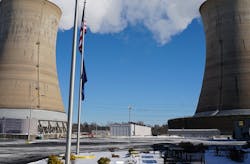Three Mile Island Reactor Returning in 2028 as Crane Center: Microsoft Signs 20-year Nuclear PPA with Constellation
Microsoft has signed a 20-year power purchase agreement (PPA) for carbon-free power with Constellation Energy, but not the usual one financing a wind or solar farm.
The new PPA is Constellation’s largest ever with Microsoft, so big that the energy company will restart closed Three Mile Island’s nuclear-powered Unit 1 close by the Susquehanna River in central Pennsylvania. The reactor was shut down for economic reasons five years ago and is not the same unit that suffered a meltdown in the late 1970s.
The move connects Microsoft’s goal of net-zero emissions to match its data center growth now and the future. The financial agreement also could keep Three Mile Island Unit 1 open, although under a new name, for decades generating carbon-free emissions.
“Powering industries critical to our nation’s global economic and technological competitiveness, including data centers, requires an abundance of energy that is carbon-free and reliable every hour of every day,” Joe Dominquez, CEO of Constellation, said in a statement. “Nuclear plants are the only energy sources that can consistently deliver on that promise.”
The restart is expected to happen in 2028.
Three Mile Island was shuttered years ago as utilities predicted flat load growth and nuclear plants could not compete economically with gas-fired and renewable energy resources. The intermittency of wind and solar, however, has combined with the sudden rise in cloud-based and artificial intelligence (AI) capacity buildout to make nuclear potential viable again. The industry still generates close to 19% of total U.S. utility-scale electricity, according to the federal Energy Information Administration.
Forecasters and data center leaders are now warning of an energy supply crisis as perhaps 50 GW of AI-centered hyperscale and colocation facilities are built and brought online in the coming decade. Microsoft itself began exploring relationships with nuclear energy providers, including small modular reactor designers, in the past few years.
Three Mile Island Unit 1 is located close to Unit 2 which was shut down in 1979 and later decommissioned. The partial meltdown caused years of bad publicity for the nuclear industry, although no deaths nor lasting health impacts were documented from the mishap.
The new Microsoft deal will reconnect 835 MW of power generation into the PJM Interconnection grid and offset the anticipated demand increase from the data centers. It also will pave the way for the project to pivot as the renamed Crane Energy Center, in honor of former Constellation parent company Exelon Corp. CEO Chris Crane. Crane, who was a big proponent of nuclear energy in the generation mix to meet environmental goals, retired in 2022 and passed away earlier this year after a brief illness.
Planners for the restart of Three Mile Island into the Crane Energy Center estimate it will add $16 billion in gross domestic product statewide, restore hundreds of job lost with the closing and reduce 61 million tons of carbon dioxide emissions over 20 years.
It also strengthens Microsoft’s emissions profile.
"This agreement is a major milestone in Microsoft's efforts to help decarbonize the grid in support of our commitment to become carbon negative. Microsoft continues to collaborate with energy providers to develop carbon-free energy sources to help meet the grids' capacity and reliability needs," said Bobby Hollis, vice president of Energy at Microsoft.
The tech industry has touted its investments in cleaner energy resources for the past decade, including billions spent on renewable energy PPAs. In recent years and with the anticipated growth of the data sector, companies such as Microsoft, Google and Amazon have expressed interest in nuclear energy to help bridge resiliency and sustainability goals.
Earlier this year, Amazon Web Services acquired a 960-MW data center facility in a deal with Talen Energy that directly connected the campus to the nearby Susquehanna nuclear plant also in Pennsylvania. The agreement has come under some legal and regulatory challenges, but is still in place.
Earlier this month, software giant Oracle’s founder Larry Ellison revealed plans for a 1-GW data center that would be powered by SMR nuclear.
Many Paths to Net Zero in the C&I Energy Transition
Subscribe to EnergyTech's Free E-Newsletter to Track It All
Companies such as Natura Resources and Oklo are working on microreactor research and design projects. Oklo and TerraPower, among others, are moving toward construction phases and supply agreements with customers.
Three Mile Island’s first unit started operations in 1974 with Unit 2 added four years later. The partial meltdown shuttered Unit 2 only a year later, but Unit 1 delivered power for 40 more years.
Numerous U.S. nuclear power plants are reaching 60 years of age and many are being re-licensed for another 20 years. The only new reactor construction project was the Vogtle 3 and 4 expansion which was completed this past year.
The Vogle Generating Station in Georgia is now the nation’s largest producer of carbon-free electricity.
About the Author
Rod Walton, EnergyTech Managing Editor
Managing Editor
For EnergyTech editorial inquiries, please contact Managing Editor Rod Walton at [email protected].
Rod Walton has spent 17 years covering the energy industry as a newspaper and trade journalist. He formerly was energy writer and business editor at the Tulsa World. Later, he spent six years covering the electricity power sector for Pennwell and Clarion Events. He joined Endeavor and EnergyTech in November 2021.
Walton earned his Bachelors degree in journalism from the University of Oklahoma. His career stops include the Moore American, Bartlesville Examiner-Enterprise, Wagoner Tribune and Tulsa World.
EnergyTech is focused on the mission critical and large-scale energy users and their sustainability and resiliency goals. These include the commercial and industrial sectors, as well as the military, universities, data centers and microgrids. The C&I sectors together account for close to 30 percent of greenhouse gas emissions in the U.S.
He was named Managing Editor for Microgrid Knowledge and EnergyTech starting July 1, 2023
Many large-scale energy users such as Fortune 500 companies, and mission-critical users such as military bases, universities, healthcare facilities, public safety and data centers, shifting their energy priorities to reach net-zero carbon goals within the coming decades. These include plans for renewable energy power purchase agreements, but also on-site resiliency projects such as microgrids, combined heat and power, rooftop solar, energy storage, digitalization and building efficiency upgrades.


